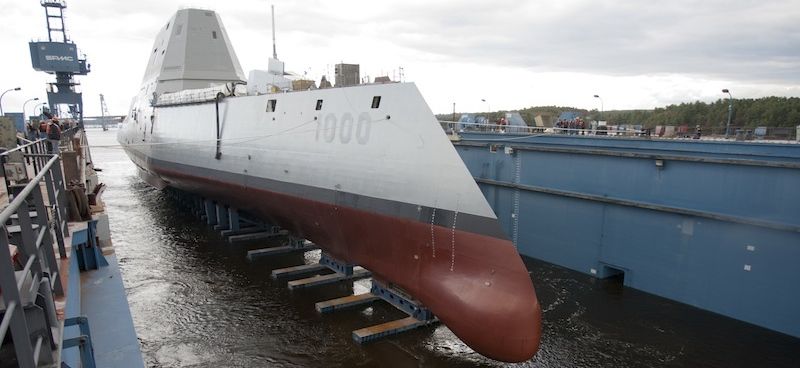Navy Faces Budget Shortfall Even If Sequester Goes Away
Posted on

Even if Congress somehow rolls back sequestration, the Navy’s fiscal situation will be uncomfortably tight, like trying to steer a battleship through the Panama Canal. Under the president’s five-year budget plan — which assumes sequester away — the “real buying power” for the Navy and the Marine Corps declines after fiscal year 2016, the Navy Department’s official budget book admits. And the Navy budget director, Rear Adm. William Lescher, told reporters at the Pentagon today that if funding stays at sequestration levels, the Navy would lose $39 billion and “would not be able to execute the strategy.”
Although the ’15 request for $174.7 billion fits under the Budget Control Act caps, Navy spending jumps above the spending cap by $12 billion in fiscal year 2017 and stays well over the limit through FY19. Yet despite going over sequestration levels, the budgeted funding across the 2015-2019 Future Years Defense Plan (FYDP) is $38 billion less than envisioned in the FY14 request.
The Navy budget, similar to the overall DoD plan, focuses on improving readiness and global “presence,” which the Navy and Marine Corps claim as their primary reason to exist. That is reflected in a request for $46.8 billion in operations and maintenance funding, up slightly over the current year. Personnel spending at $45 billion also is higher, despite a continued reduction in Marine end strength to 182,700, while Navy personnel are leveling off at about 323,000: Pay and benefits per person are simply going up faster than the services are cutting people.
The Marine manning includes most of the additional 1,000 Marines Congress ordered for increased embassy security.
Meanwhile, modernization suffers, with procurement down to $38.4 billion. The proposed funding would buy 44 ships over the FYDP, which includes 14 Littoral Combat Ships, 10 DDG-51 Arleigh Burke destroyers, and 10 Virginia-class attack submarines. The Littoral Combat Ship buy drops by one LCS in FY15 but stays at three over the rest of the plan, instead of going down to two a year as previously planned. Defense Secretary Chuck Hagel ordered the Navy to stop procurement of the LCS at 32, 20 less than planned, and consider whether to buy a modified LCS or an entirely different design.
The budget also would fund another Ford-class aircraft carrier, with construction starting in FY18; one America-class amphibious assault ship; four fleet ocean tugboats; one Afloat Forward Staging Base (AFSB), an addition over prior budgets that reflects the importance of these low-cost vessels to the Navy strategy; and three T-AO(X) fleet oilers, the first one in FY16. Design and contract awards for the oiler have not been awarded, but they would likely go to San Diego-based NASSCO, which would have no other Navy work after the AFSB.
The Navy budget funds operating the nuclear-powered aircraft carrier George Washington through the fiscal year. But, Lescher said, a decision on whether to put the Washington into the multi-billion-dollar overhaul and refueling or retire it — taking the carrier fleet permanently down to 10 — would be made next year, based on whether sequestration remains in effect.
The budget also calls for putting 11 of the Navy’s 22 cruisers into a “phase maintenance” status, which means they will be out of service with minimal manning, until money becomes available to put them through a modernization program. Members of Congress fear that would mean a permanent loss of those ships, which are about halfway through their planned service life. But Lescher insisted the Navy was committed to upgrading those cruisers.
On the aviation side, the budget would buy 470 aircraft over the 2015-2019 future years defense plan (FYDP). That includes a total of 105 Joint Strike Fighters: 69 F-35B jump jets for the Marines and 36 carrier-capable F-35Cs for the Navy. It also would fund 25 E-2D Hawkeyes across the FYDP, 56 P-8A Poseidon patrol aircraft, one KC-130J for the Marines , and 29 MH-60R and eight MH-60S helicopters for the Navy.
The total aircraft number is down substantially, reflecting a cut of 29 Navy MH-60R helicopters planned for FY16 and a slowdown in the F-35C buy. The budget asks for no FA-18 Super Hornets or EA-18G Growlers, which would end the procurement of the Boeing-built jets, unless Congress overrides that decision. There’ve been growlings on Capitol Hill about buying more Growlers and Hornets, and the many F-35 skeptics in the Navy wouldn’t mind — but so far no one’s found the money.
Subscribe to our newsletter
Promotions, new products and sales. Directly to your inbox.
